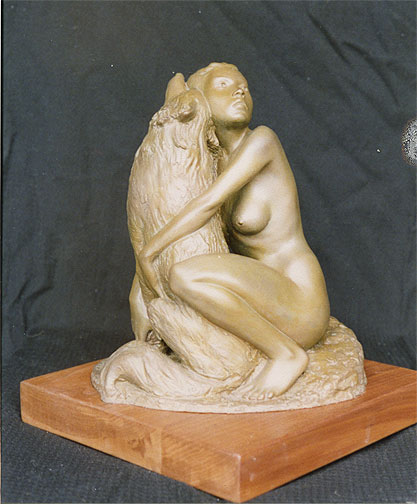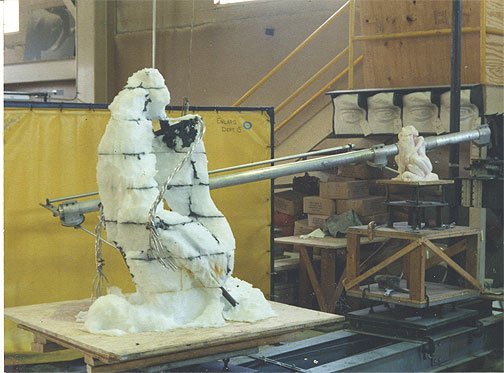

Enlarging and Reducing Sculpture
3D Pantograph
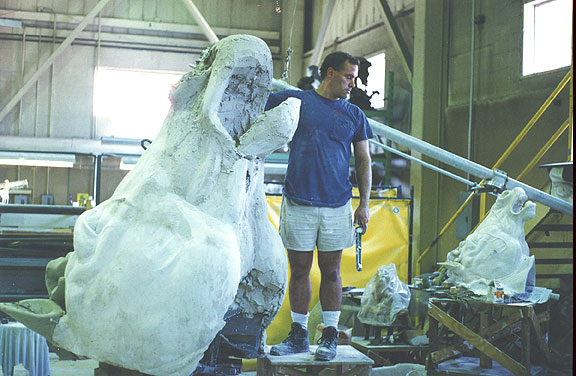
Keropian using 3D pantograph to enlarge head of horse in structo-lite.
Throughout the centuries sculptors have used various methods to enlarged and reduce their sculpture from a smaller clay or stone model to life-size to monumental sizes: From the Egyptian Box method or using a set of caliper points to today's digital 3 d printing and cnc milling technology these methods help the sculptor accurately and easily transfer or trace three-dimensional form without the need to start a work at a monumental size and to help in production speed.In most cases the figurative sculptor will first create a small model of the work no less than three times smaller then the proposed enlarging. This allows the sculptor the freedom to change and modify proportion and composition in the model before executing the sculpture to life or monumental size. This makes sense since adjusting a small mistake is far easier than adjusting or fixing a big mistake. Keeping this in mind, the sculpture model should be as accurate in regard to proportion as possible before having the work enlarged. It is not recommended to enlarge a work more than three times as there will be no doubt significant modifications needed on the enlarged sculpture. Any proportional changes to a monumental sculpture is a monumental undertaking, and will not only take more time but add to the cost and time. However all artists choose their own path and the techniques and methods will vary from sculptor to sculptor.I happen to own a three-dimensional pantograph machine designed by sculptor Berthold Nebel (1889–1964) and modified by sculptor/engineer Bruce Hoheb in the 1970's. I will briefly discuss the process below. There are a number of reasons why I prefer the 3-d pantograph over the current cnc milling technology for enlarging figurative sculpture. Certainly both methods can give a very accurate copy of the sculptor's work and save the sculptor hours of sculpting an enlarged work by eye and caliper or using a set of points.The 3-D Pantograph/Tracer allows the sculptor to start his enlarging from the armature out to the surface, capturing the details of the final surface in clay at any thickness he requires.Currently CNC milling creates the foam sculpture in sections first, the foam sections need to be glued together and if needed, an armature must be made to hold or stablize the foam sculpture before applying clay to the surface. In order to incorporate an armature, the foam has to be recut and shaped around the armature structure. This takes considerable time and effort which can add to the cost of the project and cause distortion. Another point I shall make is that a digital enlarging is generally scanned to the final detailed surface of the sculpture in a foam material. Meaning if you add a thin layer of clay on top of the digitized rendering in foam (which is the general practice) the surface is now higher than your original surface. Unfortunately this doesn't allow the sculptor the freedom to do more than surface work in clay. If you go with a less accurate scan (no surface detail) you would be basically resculpting all the surface planes and shapes of your work. Finally the cost is approximately the same as using the manual pantograph method.The image below shows the pantograph/tracer in the studio. Some of the essential parts are marked. Specific adjustments and calculations must be made to the machine prior to undertaking any project. |
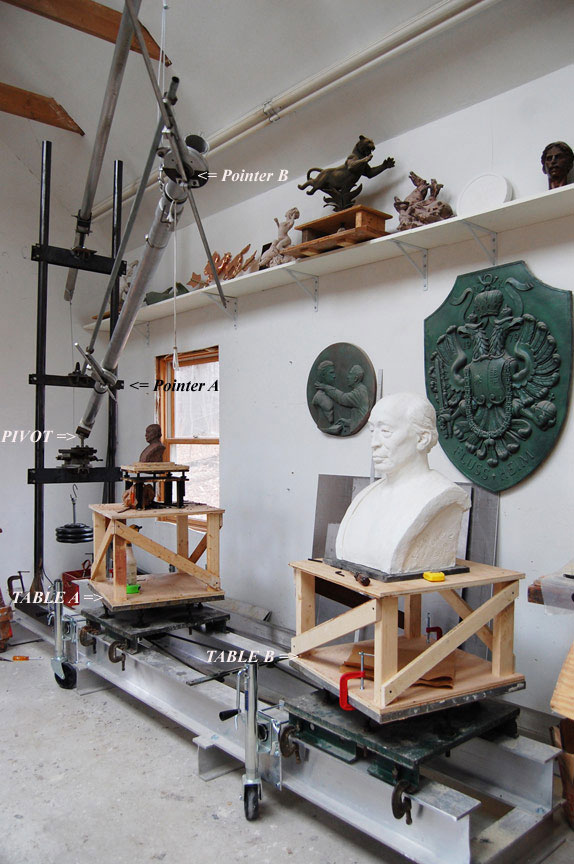
The following images explain the basic process for enlarging a sculpture.
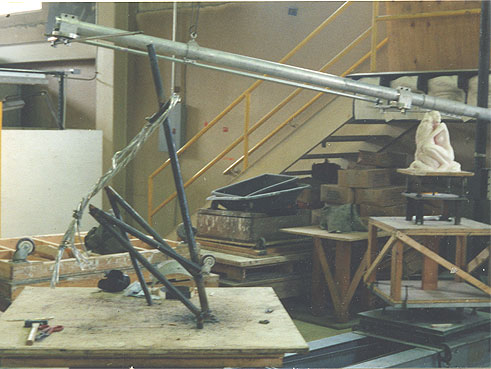
By adjusting the distance between pivot and the pointers you can calculate the size of enlarging or reduction you require. Above image shows the model on the right and armature of enlarged sculpture on left. They both sit on stable and level ball bearing tables which move together by a chain drive. The armature was created by welding pipe to a steel frame and applying a plywood base. I wanted the arms of the figure to be able to move so I attached soft 3/8" aluminum rod to the piping. Before the advent of plastics and foam, a wood construction would be constructed for structure of the sculpture and thin wood lathing nailed to the structure. Clay would be applied directly to the lathing. If you ever see any images of these structures you would agree that the armatures were artworks in themselves. |
| Here you can see the pivot point and pointers more clearly. Once the armature was completed I applied polystyrene foam around the armature and carved down the foam below the sculpted surface. This gave me the opportunity to adjust the level of clay from the surface to whatever depth I wished. Because I was using water clay, I chose about a two inch thickness to prevent the clay from drying out too quickly. |
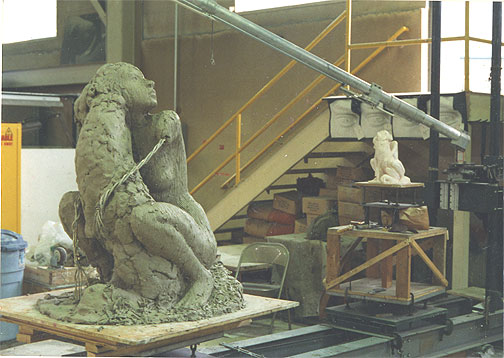
I have now added clay to the foam in the image above. I changed the stylus on the end of the left pointer to a loop tool which allows me to scrape the clay surface as I trace over the surface of my model. Once the clay has been scraped to surface it leaves slight peaks in between the scraping rows These can be removed easily enough with a rake or modeling tool. I use a smaller loop stylus and scrape in closer rows for areas like the face, hands and details. I use a larger loop stylus for and wider scraping rows for larger forms lacking detail. The process can be reversed allowing a sculptor to reduce a sculpture. The same sculpture can appear thinner when enlarged so some addtional alterations may be necessary no matter how accurate the enlarging. Just remember the importance of an accurate model to use for enlarging. Below is a bronze cast to represent the finished sculpture. More images of this sculpture are on the following page: Call for Preservation Here is a reduction of Chester Beach World's Fair Sculpture, reduced from 7 feet to 3.5 feet.
|
